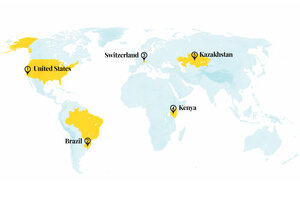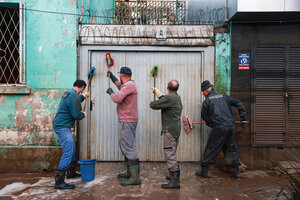Where texts and lots of photos are critical data for farmers and residents

Staff
To reduce pollution, Southern California carved a first-in-the-nation path to electrify industrial boilers
Boilers make heat for a variety of commercial uses, but they usually burn fossil fuels, releasing greenhouse gas emissions and smog-forming nitrogen oxides.
New electrification rules for a four-county area, when fully implemented, will slash nitrogen oxide pollution by 5.6 tons per day – comparable to cutting half of all smog emissions from the region’s cars. Smaller boilers in new buildings must meet zero-emissions targets by 2026, and larger facilities in existing buildings have until 2033.
Some small-business owners said the changes would impose an onerous financial burden. But the state is working on developing a rebate program to help lower costs.
Why We Wrote This
In our progress roundup: Cellphones enable so much communication that the content is not always highly valued. But in Kenya, farmers can receive sophisticated information via text messages. And in Brazil, hundreds of crowdsourced photos contribute to a map that is aiding plans ahead of the next big flood.
In a region with some of the worst air quality in the country, California’s move is a signal to manufacturers to speed development of zero-emissions equipment. Said Evan Gillespie of climate nonprofit Industrious Labs, “We want to treat this transition as an investment in modernizing industry.”
Sources: Canary Media, CBS News
A “citizen map” using hundreds of photos of individual flood experiences is helping people prepare for the next time
In April and May, in the southern state of Rio Grande do Sul, flooding displaced 650,000 people and killed 173. Sofia Royer Moraes, an environmental engineer, had begun to use Google Maps to crowdsource data for pinpointing locations and the reach of floods.
Citizen scientists take photos of how flooding has impacted them and send the images to a WhatsApp group monitored by Ms. Moraes and other researchers. By combining that information with historic flood data, the team can predict how floods might move through a community and give recommendations on what areas are safest. Mapping could allow Brazilian authorities to rethink aspects of urban planning and disaster recovery, the researchers say.
The first version of the map collected about 600 data points from 150 people. Ms. Moraes hopes that future iterations boast improved visuals and additional tracking, such as where to access clean drinking water.
Source: Yale Environment 360
Scientists invented a sweetener for chocolate using the cacao pod itself
Chocolate is made using cacao seeds that are fermented, dried, roasted, and sugar-sweetened, while most of the fruit is discarded. Combining an inner layer of the pod and the pulp, researchers at ETH Zurich created a sweet gel that makes a chocolate comparable to traditional dark chocolate in texture and flavor.
In lab testing, the method was shown to use 6% less water and land than conventional processing does. Producing the gel could also be a new income stream for farmers. Though they cultivate most of the world’s cocoa, growers in West Africa see only a sliver of the profits from the $100 billion industry. Farmers from Ivory Coast and Ghana have demanded higher pay from government regulators as sharply reduced yields have cut income.
Though the process of making the gel resulted in 12% more greenhouse gas emissions than conventional methods typically would, scientists say solar energy and scaling up the process would lower that percentage.
Sources: The Guardian, Bloomberg, Nature Food
A startup is using satellites and data science to empower small farmers with texts to their cellphones
Farmers often rely on troves of data to predict weather and other factors that affect productivity. But the information is not readily available in Africa, where 60% of the population is small-scale farmers.
Amini uses artificial intelligence to analyze data from drones, sensors, studies, and satellite imagery, and sends farmers texts to warn them about impending weather events or pest infestations. Increasingly, AI can answer farmers’ questions too. Amini’s data infrastructure has also prompted a collaboration with the African Development Bank and risk-mitigation company Aon to provide better access to crop insurance for smallholders.
By building its infrastructure locally rather than outsourcing overseas, Amini is helping to keep data scientists on a continent they often leave to seek better opportunities, said Kate Kallot, founder and CEO. The company hopes to expand its technology to Barbados, Brazil, and Southeast Asia.
Source: Fast Company
Wild horses returned to the steppes of Kazakhstan after two centuries
Named for the explorer who identified them for European scientists, Przewalski’s horses are the last species of wild horse on the planet. Prague Zoo, which has led conservation efforts for the animals, reintroduced seven of the horses to the Altyn Dala region of Kazakhstan in early June and plans to add 40 more over the next five years.
Smaller and stockier than most other equine species, Przewalski’s horses once roamed Europe and Asia but became extinct in the wild due to environmental changes and competition with humans and livestock. The group brought to Kazakhstan consists of one stallion and six mares. Two weeks after reintroduction, researchers said the horses were healthy and even mating.
Since the early 1990s, the horses have also been slowly reintroduced in China and western Mongolia, where they now number about 850.
Sources: BBC, Al Jazeera

